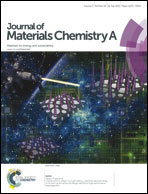Ultrasonic synthesis of highly dispersed Au nanoparticles supported on Ti-based metal–organic frameworks for electrocatalytic oxidation of hydrazine†
Abstract
In this work, Au nanoparticles supported on amino-functionalized Ti-benzenedicarboxylate metal–organic frameworks (Au/NH2-MIL-125(Ti)) were prepared by a facile ultrasonic method. The complex was characterized by scanning electron microscopy (SEM), transmission electron microscopy (TEM), X-ray diffraction (XRD), X-ray photoelectron spectroscopy (XPS), UV-Vis absorption spectroscopy and electrochemical methods. The obtained nanocomposites exhibit excellent electrocatalytic activity toward hydrazine oxidation, which is attributed to their large specific surface area and good conductivity. In addition, we found that solution pH has an obvious effect on the electrocatalytic activity of Au/NH2-MIL-125(Ti) toward hydrazine oxidation. On this basis, we constructed a simple, sensitive, selective and inexpensive electrochemical method to detect hydrazine. A linear dynamic range of 10 nM to 100 μM with a detection limit of 0.5 nM was obtained. It was demonstrated that the fabrication of Au NPs on amino-functionalized Ti-based MOFs could be promising for the sensing of hydrazine. Our results imply the potential application of metal nanoparticle/MOF nanocomposites in the field of electroanalytical chemistry.


 Please wait while we load your content...
Please wait while we load your content...